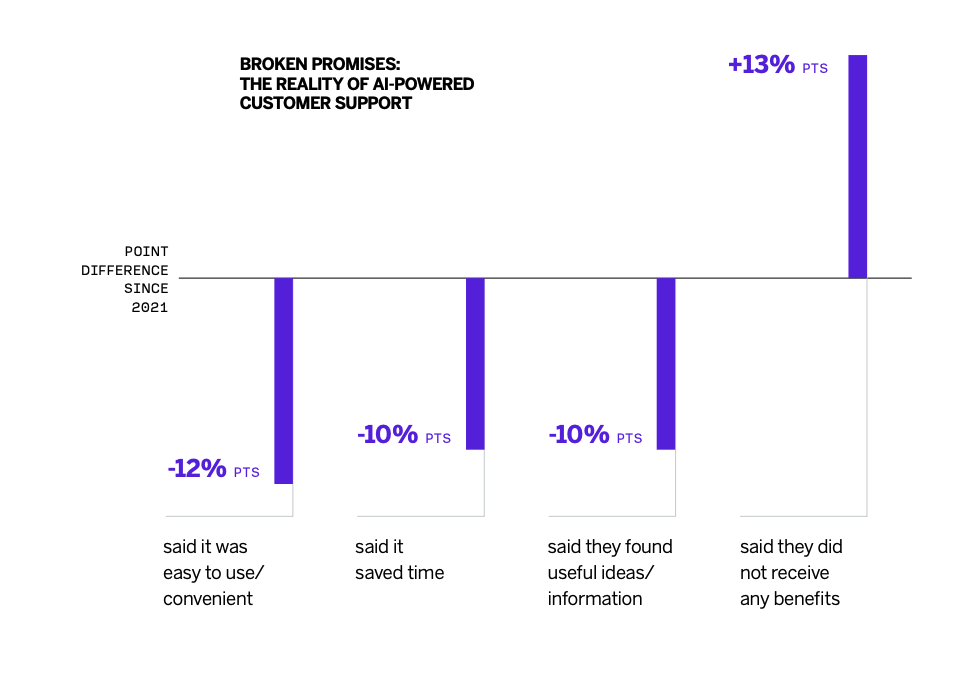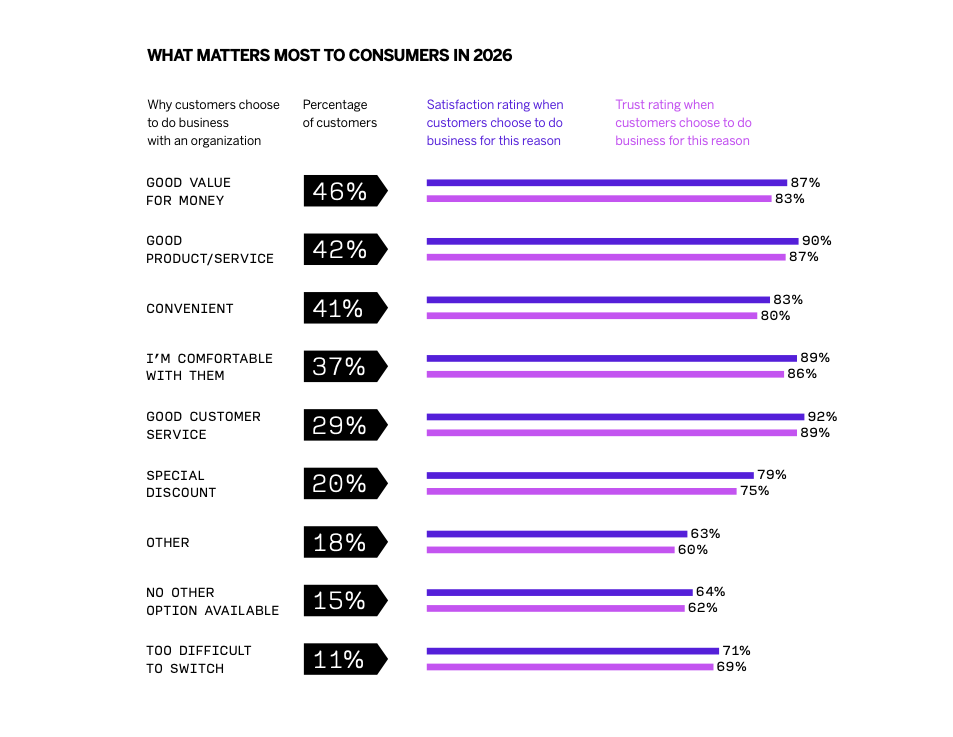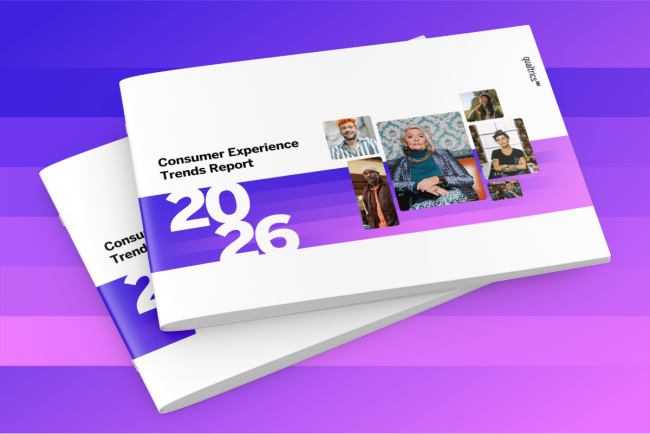We're in a rare moment. Despite economic uncertainty, consumers are surprisingly optimistic and more open to change than we've seen in years. Add breakthrough AI capabilities to the mix, and 2026 offers an unprecedented window of opportunity for businesses.
But here's the challenge: too many businesses are missing the mark. Instead of using AI to solve long-term problems, whether that’s by getting more from your existing surveys, understanding data quicker and easier than before, or automatically closing the loop with customers without having to circle back, they’re using it to solely cut costs – and customers can tell the difference. Businesses are at a crossroads: is AI a short-term fix, or a long-term solution that could revolutionize how well you know your customer and ensure they keep on coming back?
Our latest global research across 20,000 consumers across 14 countries reveals what's really driving satisfaction, trust, and loyalty in this unique moment, and how customer-centric businesses can seize the opportunity to make a lasting impact.
Here are the four key themes businesses need to know in 2026.
Download the 2026 Global Consumer Experience Trends Report
Understanding tomorrow’s consumer experience trends
Here’s the good news: research shows measurable improvements across key behavioral traits like trust, satisfaction, and likelihood to recommend. In other words, people want to buy more from brands they love.
Satisfied customers are more likely to:
- Recommend (4.1x)
- Trust (3.8x)
- Purchase more (2.3x)
However, these improvements are fragile – 1 in 2 bad experiences leads customers to cut spend. We see this most clearly in “easy-switch” industries, where customers can move freely between brands. In these markets, loyalty follows best-in-class experience and particularly strong products and services.
4 global consumer experience trends shaping 2026
Today’s consumers live in contradictions. They want personalized experiences but resist sharing data. They demand fast responses yet still crave human connection through digital channels. They’re price-conscious in their purchasing decisions – but willing to spend if they deem the experience to be worth it.
Understanding these shifting consumer behavior patterns and consumer expectations requires two things: the right tools and a direct route to the factors influencing customer choice.
1. AI-powered customer service is failing, so far
AI has transformative potential, but many organizations are racing ahead without balance. Replacing human connection with basic customer service chatbots is eroding trust among many consumers.

Customer support suffers most when AI doesn't measure up. In fact, research shows that enthusiasm for AI-driven support is much lower than the average across all AI tasks.
The reality of AI-powered customer support:
- -12 pts said it was easy to use/convenient
- -10 pts said it saved time
- -10 pts said they found useful ideas/information
- +13 pts said they did not receive any benefits from it
Scaling AI is as much about trust and change management as it is about technology. Success relies on gradual adoption, building confidence, and anchoring on trust.
- Julie Holterhaus, Maturity PLG Lead, Product Scientist, Qualtrics
Trust matters here. 53% of consumers worry AI-enabled support poses privacy risks, and half miss the human touch it replaces.
The solution? AI delivers best when it’s in a supporting role to human customer service agents – and not replacing them.
“Companies that design AI to support the relational, not just enhance the transactional, are offering the best customer experience.”
- Matt Trickett, XM Strategist, Qualtrics
2. Survey fatigue leaves businesses guessing about customer churn
Surveys are no longer enough to understand consumer behavior. Since 2021, direct customer feedback has declined, with only 3 in 10 respondents explaining why they leave – leaving businesses blind to their mistakes.
We’re also seeing:
- 15% fewer consumers post on social media after a bad experience compared to five years ago.
- 29% are less likely to share feedback directly.
- 30% don’t tell anyone — they just switch brands silently.
Response rates have been falling for years, and they’re not coming back.
- Isabelle Zdatny, Head of Thought Leadership, Qualtrics XM Institute
That puts the onus on businesses to piece together emerging trends in real time – the behavioral cues, the abandoned carts, the support call transcripts and the customer journeys all tell a story and leave you perfectly positioned to identify and solve problems before it leads to customers going elsewhere.
3. Value won’t be enough to secure customer loyalty in 2026
Rising costs make customers more price-conscious than ever in their purchase decisions – with ‘good value for money’ sitting as the leading factor driving customer choice in our 2026 survey.
But, when we take a closer look at the numbers, something important stands out: trust and satisfaction are at their highest when quality and customer service – not price – are the main reasons for purchasing decisions.

The takeaway? Businesses don't necessarily need to focus on a race to the bottom. Which is good news, because it isn't financially sustainable.
Instead, they can focus on the long term – ensuring future consumers know them for delivering quality products and services, and that they will be looked after if something goes wrong.
That way, businesses can build deeper connections with customers who value more than just price, making them much more loyal customers in the long run.
4. Consumers demand transparency over personalization tactics
Personalization helps businesses attract and retain customers through digital channels – but it comes with a caveat. While research shows some 64% show a genuine appetite for tailored experiences, only 41% believe the benefits justify the privacy costs.
The tension is clear: consumers want both a personalized customer experience and privacy. What’s missing is trust.
In our survey, only 39% of consumers believe organizations use their personal information responsibly – and there’s a sharp drop-off in acceptability as things get more pervasive:
Consumer comfort with personalization methods:
- 30%: Learning habits, remembering website behavior
- 27%: Predictive ordering
- 16%: Device listening/watching
- 32%: None of the above
To win back this trust and create frictionless experiences, it’s important that brands show what’s going on behind the curtain. 46% of customers will more willingly share their info if businesses become more transparent about what’s being collected, while 45% expect to have the ability to control and/or delete their collected data themselves.
“Don't just publish a [customer data] report,” says Terry Anderson, Senior Product Scientist, CX for Locations, Qualtrics. “Have your Head of CX record a short video and post it where your customers actually are, like Instagram or in your app. In it, they can say, 'You told us in your feedback that X was frustrating. We listened. We made change Y, and it's already resulted in Z benefit for you.' This approach turns data collection from a one-way extraction into a tangible, bi-directional conversation.”
The brands that thrive in 2026 will treat personalization as a value exchange: transparency and control in return for tailored, memorable experiences.
Get the full picture on global consumer trends
Download the complete 2026 Global Consumer Experience Trends report for free.
Inside, we dive deeper into key trends and explore what they mean for businesses in 2026 and beyond – all while focusing on the most important part of consumer research: actionable steps businesses can take to stay ahead in customer trust, customer satisfaction, and brand loyalty.
That's rich industry analysis and insight from 20,000 consumers across fourteen countries, distilled into a clear roadmap for the next 12 months in customer experience.



